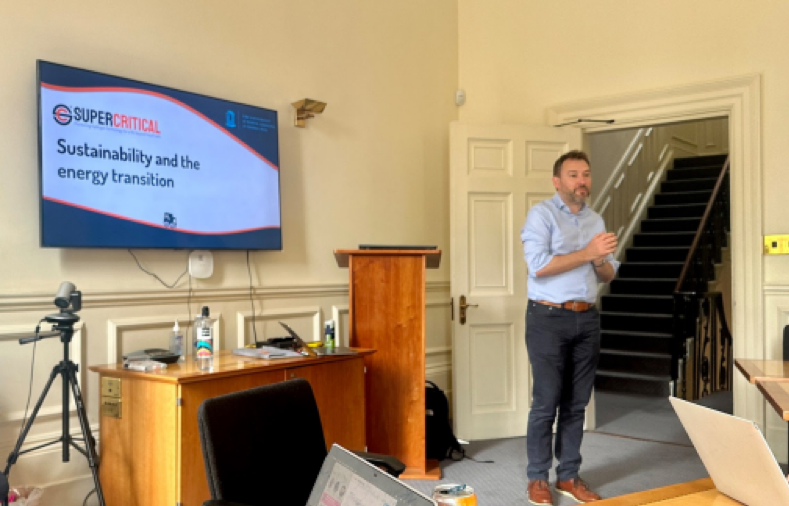Green Hydrogen and Sustainability as the Future of Design
July 19, 2023
The day began with students gathered in the UNC Winston House with coffee in hand. The morning was dedicated to working on a challenging case study paper. We bounced ideas off one another, allowing us to think critically and approach our paper topics from various angles. Following the intense morning session, the rest of the students gathered for a debrief led by our professor Greg Gangi. We reflected on our experiences in Hull from the prior week and had an engaging conversation about our lessons learned. I was interested in the level of collaboration between industry and academia in Hull. There is a need to foster partnerships with the private sector in the United States, and the city provides a good example.
 Next on the agenda was a presentation by Matt Bird, the CEO and co-founder of Supercritical Solutions. He discussed what makes his company special, the challenges they face, and their next steps. As we attentively listened, we were inspired by his innovation and entrepreneurship. The company is developing the world’s first high-pressure, ultra-efficient electrolyzer for the production of green hydrogen. They recognize that hydrogen is not new, and it is only going to increase in demand. The company started when Deep Science Ventures created a team of 4 people to use science to find solutions to big problems. Matt’s team invented an electrolyzer that is over 99% efficient in the electrolysis stage. It is delivered at 230 bar pressure, 400 degrees Celsius, and in an alkaline solution. Additionally, they use membrane-less technology and an all-metal design. This type of product is hard to create because of the safety aspect and the need to solve fundamental problems in green hydrogen.
Next on the agenda was a presentation by Matt Bird, the CEO and co-founder of Supercritical Solutions. He discussed what makes his company special, the challenges they face, and their next steps. As we attentively listened, we were inspired by his innovation and entrepreneurship. The company is developing the world’s first high-pressure, ultra-efficient electrolyzer for the production of green hydrogen. They recognize that hydrogen is not new, and it is only going to increase in demand. The company started when Deep Science Ventures created a team of 4 people to use science to find solutions to big problems. Matt’s team invented an electrolyzer that is over 99% efficient in the electrolysis stage. It is delivered at 230 bar pressure, 400 degrees Celsius, and in an alkaline solution. Additionally, they use membrane-less technology and an all-metal design. This type of product is hard to create because of the safety aspect and the need to solve fundamental problems in green hydrogen.
Matt went in-depth into the process of green hydrogen as shown above. He discussed their work in two companies: WhiskHy and GreenNH3. WhiskHy uses a high-pressure and ultra-efficient electrolyzer to produce green hydrogen to directly fire whisky. It is a low-cost way to decrease greenhouse gas emissions from whisky distilling. GreeNH3 uses the electrolyzer to produce ammonia-grade hydrogen, decreasing the cost of green ammonia by 21%. Then, he went into the target sectors and the next steps for the company. Matt thinks it is most beneficial to focus on the chemical, industrial heat, and heavy transport industries. With Supercritical Solutions still in its startup phase, two more years will be dedicated to R&D. Next, there will be a pilot program in place for the 3 sectors. I had a question about some challenges they face in scaling their technology. Matt explained as they expand, it gets more expensive. While there are various investors, funding could pose an issue.
The day finished with the class presenting their photojournalism projects. I was impressed by the diversity in topics, unique perspectives, and creative work of my fellow classmates. Each student chose an area of sustainability in the places we have traveled, including Germany, France, Switzerland, Netherlands, and the United Kingdom. I did a visual presentation exploring the power of passive design. I hoped to increase the awareness of passive design concepts and show how sustainability can be the future of design.
This eventful day was filled with academic rigor and inspiration. We worked on a case study paper in the morning, then attended an engaging presentation by Matt Bird in the afternoon, and finally shared our photojournalism projects. Such days present opportunities to reflect on our study abroad trip and develop an understanding of the complexity of a field that we are so passionate to study.
About the Author
This article was written by Ashley Titus, Class of 2025 majoring in Neuroscience and Environmental Science.
